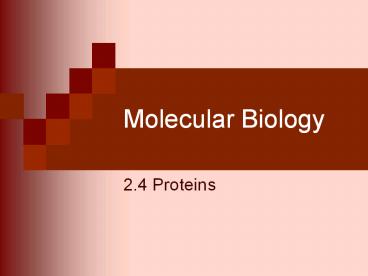Molecular Biology - PowerPoint PPT Presentation
1 / 20
Title: Molecular Biology
1
Molecular Biology
- 2.4 Proteins
2
PROTEINS
- Made of C, H, O and N
- Proteins are large molecules constructed of many
amino acids - Most abundant organic compound found in living
cells
3
Most important macromolecule in the body
Proteins Rule Everything!
PROTEINS
- Functions?
- Structural parts
- nails, hair, cell membrane, and cartilage
- Pigments
- skin, eyes, and chlorophyll
- Hormones and receptors
- Muscle contractions
- Immunity-Antibodies
- Enzymes
- Cytoskeleton
- Blood clotting
- Transport of nutrients/gases
- Cell adhesion
- Cell membrane transport
- Packing of DNA
4
PROTEINS
- Total energy gain is 4 Calories/gram. (however,
energy gain is not their main function).
5
PROTEINS
- Amino acids are linked together by condensation
reactions to form polypeptides. - The building blocks of proteins are amino acids.
6
PROTEINS
- Amino Acids
- Centre carbon atom
- Bonded to
- Hydrogen (H)
- Amine group (-NH2)
- Carboxyl group (-COOH)
- R- group (different in each amino acid)
7
PROTEINS
- Amino acids are linked together by condensation
reactions to form polypeptides. - The amino acids are bonded together by peptide
bonds to form proteins.
8
PROTEINS
- The bond that is formed from the acid group
(COOH) and the amino group (NH2) - Water is eliminated condensation reaction
- Proteins are frequently called polypeptides (many
peptide bonds).
9
PROTEINS
- The smallest polypeptide consists of 20 amino
acids (less than that called an oligopeptide) - Insulin contains 2 polypeptides 21 amino acids
and 30 amino acids - Human titin has 34 350 amino acids
10
PROTEINS
- There are 20 different amino acids used by
ribosomes to make polypeptides
11
PROTEINS
- Draw molecular diagrams to show the formation of
a peptide bond - Locate the Amine, Carboxyl, and R-groups
- Show the formation of a peptide bond between 2
amino acid - Try to draw an oligopeptide with all 4
Alanine
Serine
Glutamic acid
Glycine
12
PROTEINS
- Did you notice?
- The amine and carboxyl are used in the peptide
bonds - Chain of atoms linked with single bonds form
backbone - H attached to N by single bond
- O attached to C by double bond
- The R-groups remain
Alanine
Serine
Glutamic acid
Glycine
13
PROTEINS
- The amine and carboxyl group are used in the
condensation reaction - The R-groups give the polypeptide its character
- The R-groups provide an amazing range of proteins
14
PROTEINS
- Some proteins contain amino acids not contained
in the list of 20. - This is due to modification after a polypeptide
has been made. Example hydroxyproline in
collagen
15
PROTEINS
- Patterns, trends, discrepancies most but not all
organisms assemble polypeptides from the same
amino acids. - We can exclude the possibility that this trend is
due to chance - What reasons would account for almost all
organisms using the same 20 amino acids? - These were the ones produced before life
- These are the ideal
- All life evolved from a single ancestral species
16
PROTEINS
- Amino acids can be linked together in any
sequence giving a huge range of possible
polypeptides
17
PROTEINS
- Calculate the possibilities
Number of Amino Acids in the Chain Number of possible sequences Number of possible sequences
1 201
2 202 400
3 8000
4
64 000 000
18
PROTEINS
- Shapes
- primary (linear)
- secondary (ß-pleated sheets and a-helix)
- tertiary (bent-coiled)
- quaternary (compact with a specific structure).
19
PROTEINS
- You can unfold a protein (de-nature) by exposing
the protein to heat, radiation or a change in pH.
(i.e. frying an egg, baking a cake, UV exposure,
x-rays).
20
Questions
- What 2 functional groups do all amino acids have
in common? - Draw a generic formation of a peptide bond.
Identify the amino terminus, carboxyl terminus,
and peptide bond. - Define primary structure.
- Name the 2 types of secondary structure. What
type of bond stabilizes this structure? - Distinguish between polypeptide and protein.
- Why do proteins have more diverse functional
roles than carbohydrates?































